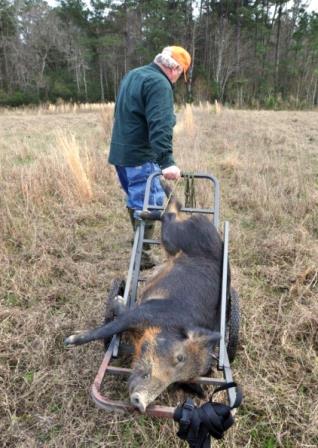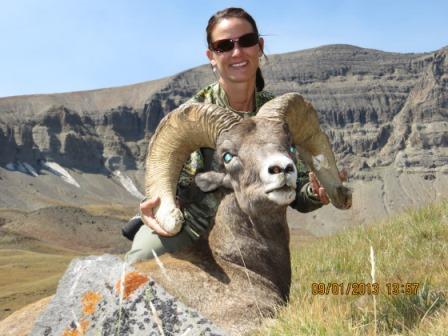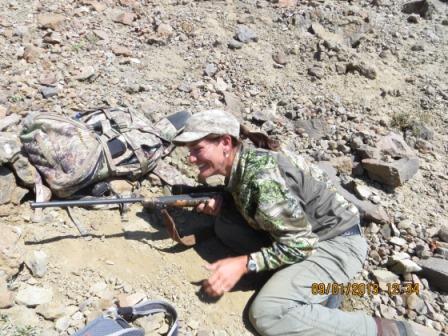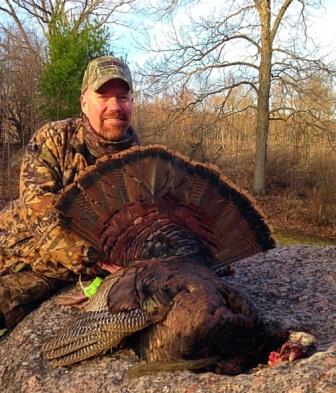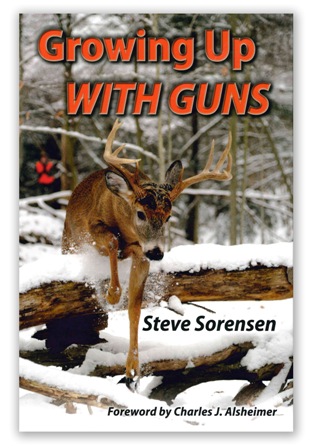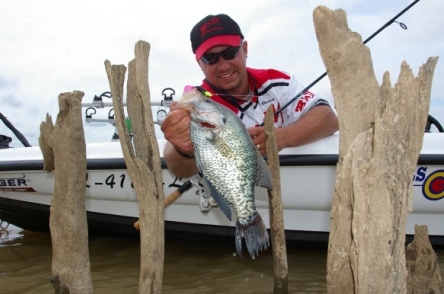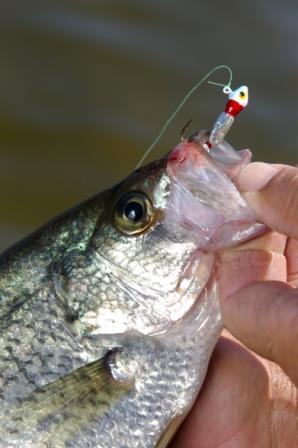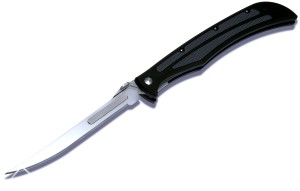By Mike Marsh
Six calling tactics for more successful
hog hunting!
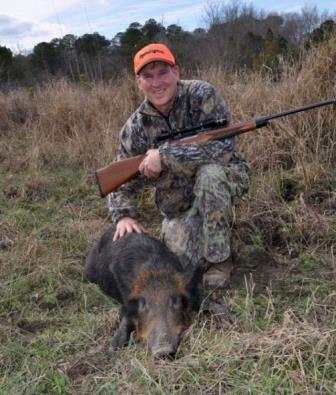
Mike Marsh took this 200-pound sow on a WMA where bait, night hunting and hound hunting are not allowed. In such situations, using a call is the last resort method that can work if the hunter is persistent. (Photo: Mike Marsh)
Call them feral pigs, wild hogs or wild boar. The feral swine that have infested the landscape in many areas of the U.S. are nuisance animals to some, bonus big-game animals to others. Hog hunters take them by many methods including the use of bait, artificial lights and packs of hog dogs. However, the most underutilized and misunderstood tactic is using calls to increase the odds of seeing hogs. Here are six tips and tactics for making sounds that may help you home in on a sounder of hogs the next time you go out.
1. Using mouth calls
Most call manufacturers make some variation of reed-style mouth calls for hogs. Like choosing a favorite duck or turkey call, finding a mouth call that works takes a lot of trial-and-error experience. Hogs seem to be extremely sensitive to the specific calls they respond to, as well as to the various sounds a hunter makes with those calls. A single hog call tuned for a specific age or sex — piglet, boar or sow — has the best chance of success.
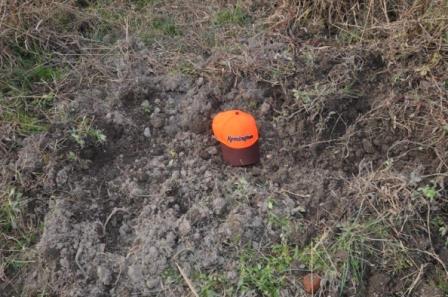
Hogs dig up large areas when rooting for invertebrates and tubers. Recently rooted areas indicate hogs are nearby and may be susceptible to calling. (Photo: Mike Marsh)
Hunters who master hog squeals and grunts with their own natural voices seem to have better luck than those who use mechanical calls. Pigs sometimes respond to turkey and rabbit calls, likely because they mimic piglets, but the high-pitched calls may also arouse a predatory instinct. Yes, wild pigs are predators. They’re also scavengers, meat-eaters, omnivores — they turn up their snouts at nothing.
2. Using electronic callers
Electronic callers have several advantages over mouth calls. A hunter can position an E-call away from his location to keep him out of harm’s way in case an aggressive hog decides to come in quickly. An E-call can be set to scroll through a lengthy repertoire of sounds at one sitting to increase the odds of at least one of them attracting attention. The best calls are recordings of real piglet squeals and feeding herds.
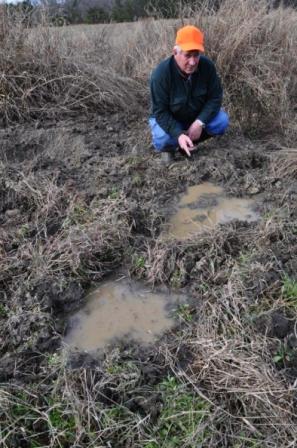
Basil Watts found these hog wallows on a public game land. The muddied water shows that hogs were recently taking a mud bath. (Photo: Mike Marsh)
3. Checking for sign before deciding to call
Hog sign includes tracks, wallows, droppings, rubs and musky scent. These are indications the area is used by a sounder of sows with young or a solitary boar. Each of these situations requires different hog calls. Making a boar grunt accompanied by kicking a wallow could bring a dominant boar on the run. High-pitched squeals of an injured piglet may induce a brood sow to respond. Think about these factors before you decide on the sounds you’ll make.
4. Evaluating every situation
As with many other varmint calling situations, calling hogs is no sure thing. It’s a long-odds proposition, so it pays to view each situation as unique. A hunter may try calling dozens of times with no luck, and many give up trying. Some use calls as a method of last resort or on public lands where bait and hounds are not legal methods. Others call to sweeten a baited set-up with an occasional oink or grunt to give pigs a sense of confidence. The most effective use I have found for a mouth call is to stop a moving pig.
5. Calling by sight
A single pig that has seen you but is not sure what you are and is moving away slowly is susceptible to calling. The best call in this situation is a single grunt, which can stop the animal or even bring it back into the open. With blind-calling set-ups, a response does not necessarily mean an animal is approaching your blind — it may simply be a vocal response. A hog answering a call gives the hunter the opportunity to sneak closer, or alerts him as to the best direction to watch.
6. Thinking safety
Making a call that incites a boar’s territorial instinct or a sow’s maternal instinct could put you in danger. You may be macho enough not to fear a single animal, but imagine multiple, angry hogs all approaching at a dead run. As a hunter who has had his back against a tree facing five angry hogs weighing more than 200 pounds apiece, and all of them popping their teeth from inside 20 feet, I can assure you that the situation elicits pulse-pounding excitement. It is most definitely not fun. Pick a safe spot when calling hogs, such as an elevated stand or a web-wire fence that serves as a barrier. Hunt with a partner who can watch your back or help track a hit hog if it runs into a thicket.
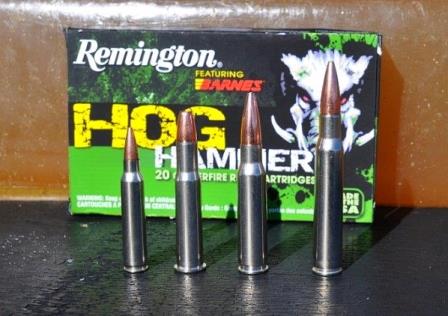
Hog specific ammo, such as Remington’s Hog Hammer with nickeled cases and the excellent Barnes TSX bullet, is tailored to taking heavy hogs. Controlled expansion bullets that provide deep penetration and large exit wounds aid hunters in recovering hogs in the thick cover they love. (Photo: Mike Marsh)
Make hog calling one of your options, and you’re more likely to bring home the bacon.
About Mike Marsh:
 Mike Marsh’s articles, columns and photos have appeared in more than 100 magazines and newspapers. He lives in Wilmington, North Carolina and has written four books about the state’s hunting, fresh-water and salt-water fishing. His latest is “Fishing North Carolina.” To contact Mike, view his award-winning articles and photos or order his books, visit www.mikemarshoutdoors.com.
Mike Marsh’s articles, columns and photos have appeared in more than 100 magazines and newspapers. He lives in Wilmington, North Carolina and has written four books about the state’s hunting, fresh-water and salt-water fishing. His latest is “Fishing North Carolina.” To contact Mike, view his award-winning articles and photos or order his books, visit www.mikemarshoutdoors.com.
There isn’t a wild hog out there that
a Havalon can’t handle! Check out our
Piranta series today! Click here:
3,184 total views, no views today


